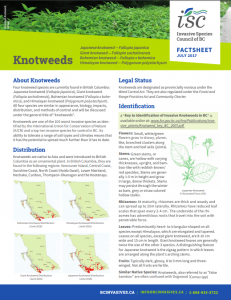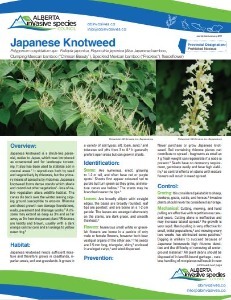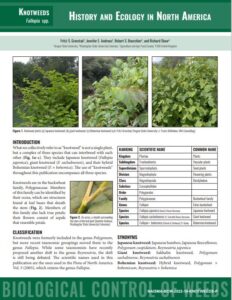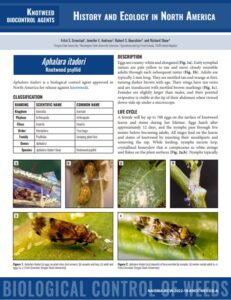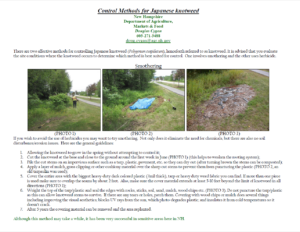Japanese Knotweed (Fallopia japonic)
French common name: Renouée du Japon
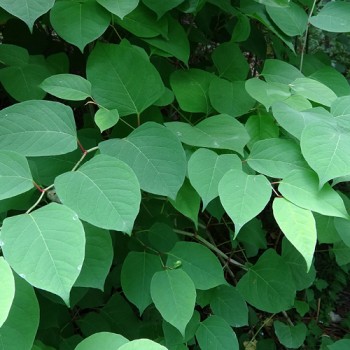
Alternate leaves are oval to triangular with a pointed tip and flat base with a long stalk (petiole) arising from the stem. They are 10-17 cm long and 7-10 cm wide and alternate along the stem in a distinctive zigzag pattern.
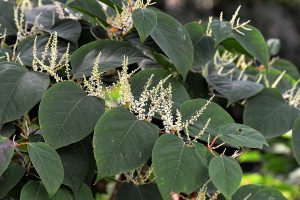
Japanese knotweed leaves.
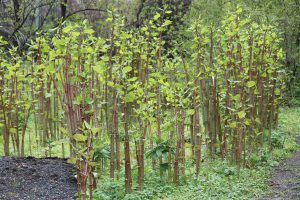
It forms dense thickets of bamboo-like vegetation that aggressively outcompetes native plants.
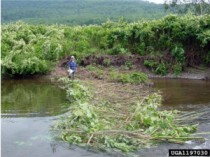
Japanese Knotweed near a stream.
Order: Caryophyllales
Family: Polygonaceae
Did you know? This plant species has been noted to damage households by growing through concrete cracks.
Japanese knotweed is native to eastern Asia and was introduced to North America as a horticultural plant in the late 19th century. It can grow in a wide range of habitats including riparian areas, wetlands, roadsides, ditches, and fence lines. It forms dense thickets of bamboo-like vegetation that aggressively outcompetes native plants and negatively impacts wetland and riparian areas. This invasive plant has hollow, smooth, purple to green coloured stems up to 2.5 cm in diameter.
Japanese knotweed is a woody-stemmed herbaceous perennial rhizomatous plant (BMP).
Stems: Japanese knotweed stems are hollow, smooth, purple to green coloured, and up to 2.5 cm in diameter. The hollow-jointed stems have reddish-brown solid nodes surrounded by a papery sheath. The stems die back each fall and the dead stalks remain standing over the winter. Numerous new stems emerge in the spring (usually late March to early April in southern Ontario) from the over-wintering root system. Juvenile stems resemble asparagus (Asparagus officinalis) spears and are purplish in colour, fading to green as they mature. Japanese knotweed can grow rapidly; stems can grow up to 8 cm per day. The plant can grow 1 m in height in three weeks, with the mature plant reaching full height by the end of July. This plant grows in large bamboo-like clumps, reaching heights of 1-3 m (3-10 ft).
Leaves: Alternate leaves are oval to triangular with a pointed tip and flat base with a long stalk (petiole) arising from the stem. They are 10-17 cm long and 7-10 cm wide and alternate along the stem in a distinctive zigzag pattern.
Flowers: Small, white-green flowers bloom in sprays near the end of the stem and in the leaf axils in late July or August. The flowers are produced in branching panicles (clusters). The seeds are winged, triangular, shiny, and very small. The fruit is winged, which assists them in wind or water dispersal. Japanese knotweed is a dioecious plant, meaning there are male and female plants which require pollination to produce viable seeds (BMP).
Rooting system: Japanese knotweed has a horizontal root system that can grow very quickly and spread up to 10 m away from the parent plant.
In Ontario, Japanese knotweed distribution is not well-documented. The majority of sites have been reported in the last 10-20 years. There have been populations confirmed as far north as Thunder Bay and Sault Ste Marie. There are established populations across southern, central, and eastern Ontario (in over 20 different municipalities). Canada-wide, the primary distribution is in Ontario, Quebec, and the Atlantic Provinces with isolated populations in Winnipeg, Manitoba and southern British Columbia.
Japanese knotweed is somewhat intolerant of persistent freezing conditions, and as a result, its spread may be confined to more southern parts of Canada. However, as the climate warms, it may be able to spread further north. Ontario should be prepared for Japanese knotweed to spread within the province as the average temperatures rise. Road and railroad rights of way and waterways are the main geographic pathways for spread within Ontario. Road maintenance, forestry operations, and construction activities may spread these plants further (Ontario, 2018).
Impacts on biodiversity
Japanese knotweed can severely degrade the quality of wetland and riparian habitats where it becomes established. Dense thickets can reduce sunlight penetration by more than 90% and its thick mats of dead and decaying vegetation in fall/spring prevent other plant species from growing by shading them out.
As a result of the reduced native plant biodiversity and lowered invertebrate densities, established knotweed stands do not support the same levels of native amphibian, reptile, bird and mammal populations. For example, it has been shown that native green frog (Rana clamitans) presence is dramatically reduced in knotweed stands in riparian/wetland areas. Although further study is needed, it is believed that Japanese knotweed may have allelopathic properties. The roots contain unique compounds, which may alter soil chemistry or prohibit the growth of nearby native species (Japanese Knotweed BMP).
Impacts on infrastructure
This plant can significantly damage infrastructure. It is able to grow through concrete/asphalt up to 8 cm thick and building foundations. It is of particular concern in new housing developments. In the United Kingdom, developers must dispose of soil containing knotweed fragments at hazardous waste facilities. Japanese knotweed root systems, while strong, are not as dense as those of native plants, and do not hold soil as well. When Japanese knotweed establishes along stream banks, the bank can become unstable and more vulnerable to erosion and flooding. Reductions in available soil (because of erosion) and space (because of the larger root/rhizome biomass) affect the ability of the stream bank to hold water during heavy rains (Japanese Knotweed BMP).
Impacts on recreation
Japanese knotweed can block or interfere with access to water for activities such as canoeing, boating, angling, and swimming (Japanese Knotweed BMP).
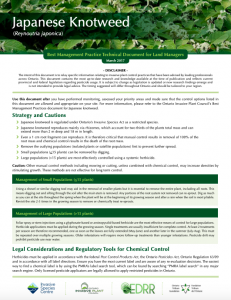
In 2017, the Early Detection & Rapid Response Network worked with leading invasive plant control professionals across Ontario to create a series of technical bulletins to help supplement the Ontario Invasive Plant Council’s Best Management Practices series. These brief documents were created to help invasive plant management professionals use the most effective control practices in their effort to control invasive plants in Ontario.
*Please note: the Invasive Plant Technical Bulletin Series is currently undergoing some updates and will be reposted when the process has been completed. Please visit the Ontario Invasive Plant Council website for updates.
Fact Sheets
Best Management Practices
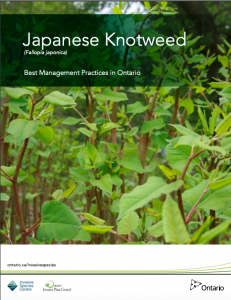
These Best Management Practices (BMPs) are designed to provide guidance for managing invasive Japanese Knotweed in Ontario. They were developed by the Ontario Invasive Plant Council (OIPC), its partners and the Ontario Ministry of Natural Resources and Forestry (MNRF) and Ontario Ministry of Agriculture, Food and Rural Affairs (OMAFRA). These guidelines were created to complement the invasive plant control initiatives of organizations and individuals concerned with the protection of biodiversity, agricultural lands, crops and natural lands.
*Please note: some BMPs are currently undergoing some updates and will be reposted when the process has been completed. Please visit the Ontario Invasive Plant Council website for updates.
Research
Evidence for massive clonal growth in the invasive weed Fallopia japonica
Britain was assessed using RAPDs (Randomly Amplified Polymorphic DNA). A total of 150
British samples was analysed for genetic variation using ten arbitrary decamer primers, and …
[BOOK] The Japanese knotweed manual: the management and control of an invasive alien weed.
japonica fallopia japonica Subject Category: Organism Names see more details [Reynoutria
japonica]) in an area as it is with its containment when the plant is already established …
Invasion of diverse habitats by few Japanese knotweed genotypes is correlated with epigenetic differentiation
adaptation. Given that the invasion process often entails population bottlenecks, it is
surprising that many invasives appear to thrive even with low levels of sequence‐based …
Stream ecosystems respond to riparian invasion by Japanese knotweed (Fallopia japonica)
little information is currently available on their influence on stream ecosystems. This study
assessed the impact of riparian invasion by Japanese knotweed (Fallopia japonica), an …
Asexual spread versus sexual reproduction and evolution in Japanese Knotweed sl sets the stage for the “Battle of the Clones”
by purely vegetative reproduction has demonstrated that reproduction by seed and the
genetic diversity associated with it may not be an essential feature of plant invasions, at least …
An overlooked hybrid Japanese knotweed (Polygonum cuspidatum× sachalinense; Polygonaceae) in North America
sachalinense. The hybrid, Polygonum× bohemicum (J. Chrtek & A. Chrtková) PF Zika & AL
Jacobson, comb. nov., is widespread and invasive across North America. We illustrate the …
Current Research and Knowledge Gaps
Lorem ipsum dolor sit amet, consectetur adipiscing elit. Ut elit tellus, luctus nec ullamcorper mattis, pulvinar dapibus leo.
Further Reading
The Invasive Species Centre aims to connect stakeholders. The following information below link to resources that have been created by external organizations.

